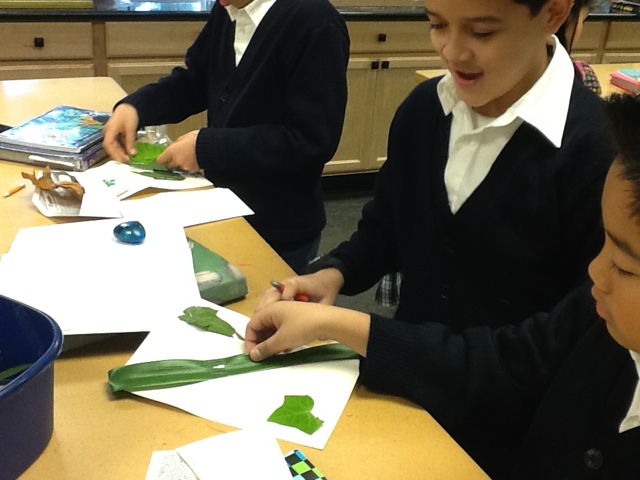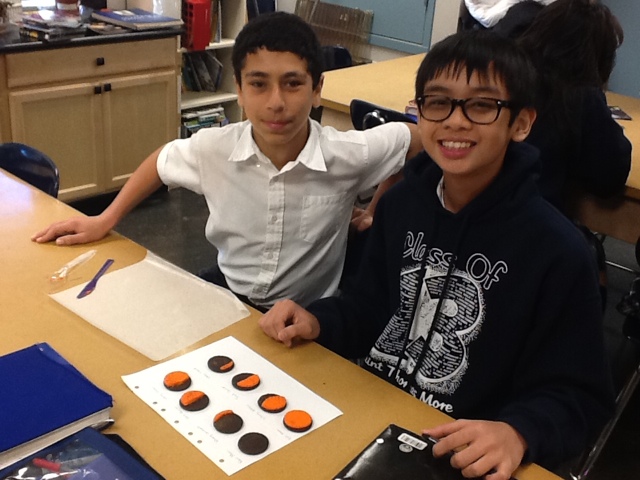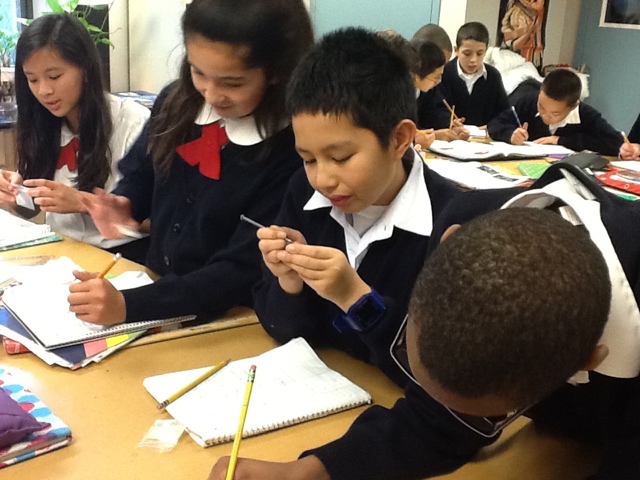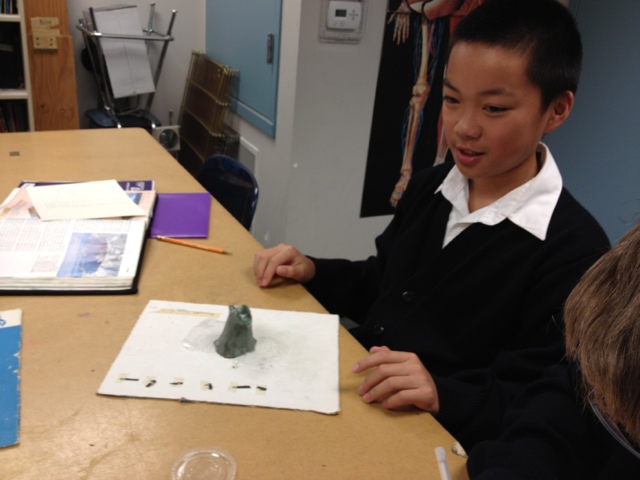Using the Educreations app, the 8th graders made brief planet presentations working with their respective table members. Afterwards, they created a short five question quiz. Each group took the quizzes.
The final challenge project!
The students worked as a team using Tinkertoys to design any type of object, vehicle or equipment that can successfully explore the planet of their choice. They built it and filmed their results explaining the virtues of their object and detailing how their designs will work.
First check out their Educreations that were created in ONE class period. This app is great and we use it quite a bit. There is a free version for iPads. I know that many high schools use this app as well as Show Me. So it is great for students to get an opportunity to familiarize themselves with this fun application.
Table 5 Patrick Brown, Devin Cagadoc-Rojo, Nizar Sweileh, Jose David present:
Lesson
Table 2: Crystal Tobar, Julie Kavanagh, Vialina Bulatov, Daniella Londero
Lesson
Table 3: Kevin Londero, Ademir Vila, Ian Ostrea, Jerome Torres
Lesson
Table 6: Elyssa Nicolas, Samantha Bernardo, Alexandra Diaz, Annalysse Santos
Lesson
Table 1: Kameron Powers, Julius Aguinaldo, Antoine Malouf, Christopher Taylor, Sean Ramos
Lesson
Table 4: Sophia Torres, Julietta Lehman, Paulina Toledo, Sydnie Gamboa
Lesson
Tuesday, December 18, 2012
Tuesday, December 11, 2012
6th grade
Working with minerals still, the students are now working to find the density of various minerals.
Lots of lab equipment being utilized: graduated cylinders, triple balance beams, beakers and the minerals.
Then there is the manipulation of the formula based on their recorded data:
Density = Mass/Volume.
Lots of lab equipment being utilized: graduated cylinders, triple balance beams, beakers and the minerals.
Then there is the manipulation of the formula based on their recorded data:
Density = Mass/Volume.
7th grade
Learning about the digestive system!!
Simulating the functions of the stomach, the students did a lab titled, "The Big Squeeze".
The problem question being: How do the muscles of the stomach aid in digestion.
Pretty messy, kind of gross...that's science!
Simulating the functions of the stomach, the students did a lab titled, "The Big Squeeze".
The problem question being: How do the muscles of the stomach aid in digestion.
Pretty messy, kind of gross...that's science!
Monday, December 10, 2012
5th grade
After learning about the anatomy and physiology of leaves, the students spent a couple of days obtaining leaf cuttings and samples and identifying various types of leaves. They used terms and sketched leaves that were: palmate, pinnate, branching and parallel venation, as well as, leaves that had other attributes: saw-toothed, flat based, lobed, etc.
In the end they will create Cinquain poems (5 lined poems) that focus on plants.
I am excited to see what they come up with.
In the end they will create Cinquain poems (5 lined poems) that focus on plants.
I am excited to see what they come up with.
8th grade
Still taking a look at the moon phases and having a little fun this morning with Oreo cookies -
Waxing or waning? Gibbous or crescent? Yum!
Waxing or waning? Gibbous or crescent? Yum!
Friday, December 7, 2012
6th grade
We are starting to work on Minerals. It's actually a pretty short unit, but it is a lot of fun.
The students are exploring various minerals - galena, hematite, calcite, etc.
They are conducting streak and hardness tests. Using Moh's hardness scale, the students first predict the hardness then test the mineral using their fingernail, a penny, a nail and a glass plate.
They are usually pretty surprised.
The students are exploring various minerals - galena, hematite, calcite, etc.
They are conducting streak and hardness tests. Using Moh's hardness scale, the students first predict the hardness then test the mineral using their fingernail, a penny, a nail and a glass plate.
They are usually pretty surprised.
5th grade
Lab titled Salt of the Earth
Students are recording observations of the affect of saltwater versus freshwater on leaves.
As they discover and record data, they work on detailing their observations. In this, their hypotheses can be validated (or not) and their conclusions can be more thorough.
Students are recording observations of the affect of saltwater versus freshwater on leaves.
As they discover and record data, they work on detailing their observations. In this, their hypotheses can be validated (or not) and their conclusions can be more thorough.
4th grade
As we move through the Water unit, 4th grade revisits the Water Cycle.
They used iPads to research and find images, diagrams or pictures of the Water Cycle. We put them on the projector and students explained the diagram and added their reasons for choosing that particular one.
They used iPads to research and find images, diagrams or pictures of the Water Cycle. We put them on the projector and students explained the diagram and added their reasons for choosing that particular one.
4th grade
Another property of water is its ability to dissolve most any substance. During this lab, the students learn terms like: solvent, solute, dissolve,and mixture.
Working as a team they explored many different substances and discerned whether a mixture was made or not.
Working as a team they explored many different substances and discerned whether a mixture was made or not.
Monday, December 3, 2012
6th grade
Making some volcanoes.
Only had a couple of pics this class period, thought I would post them.
Students made mini volcanoes:
Shield, composite and cinder-cone.
Loaded with baking soda, they added the vinegar and created eruptions.
It was messy, but they were able to see that eruptions don't always necessarily mean that lava will flow. Or due to the shape of the volcano the lava flows and forms mountain shapes.
Only had a couple of pics this class period, thought I would post them.
Students made mini volcanoes:
Shield, composite and cinder-cone.
Loaded with baking soda, they added the vinegar and created eruptions.
It was messy, but they were able to see that eruptions don't always necessarily mean that lava will flow. Or due to the shape of the volcano the lava flows and forms mountain shapes.
Subscribe to:
Comments (Atom)


















































